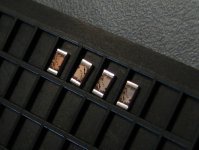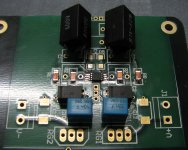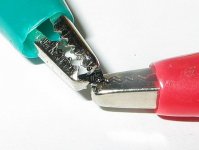Z-foil SMD
Texas COmponents´Zfoil ASM / ASMP resistors are available from 0805 size to 2512 size. 0805 is possible to solder even with my eye sight
(OK, I use enlargement glasses)
I will stick with the 0805 ASM/ASMP resistors.
/S
Texas COmponents´Zfoil ASM / ASMP resistors are available from 0805 size to 2512 size. 0805 is possible to solder even with my eye sight
(OK, I use enlargement glasses)
I will stick with the 0805 ASM/ASMP resistors.
/S
If we are into fine tuning -- the discrete R's have lower THD. I have a problem with smd when I cant read/see the part number or its value, it is a b**ch. smd is great for small spaces and automation. For me, I'll stick to the best parts (lowest distortion). Even if I have to lay out my own pcb artwork. Thx - RNM
Whats for dinner? - I'm having Pad Thai tonight- RNM
Shanghai ham, but DIY. I'm surprised you have not seen the LNL report on SMT resistors? There are several exellent choices. Texas Components is part of the Vishay group, their foil SMD resistors have excellent specs.
Last edited:
Tsk, tsk ... everyone has their own approach and ideas on things, I enjoy playing with other people's ideas, to see where that can lead, since I'm coming from a completely different perspective.
Frank
Yes, keep this a group effort. Too cold to golf today, might start up a non-SMD breadboard.
Shanghai ham, but DIY. I'm surprised you have not seen the LNL report on SMT resistors? There are several exellent choices. Texas Components is part of the Vishay group, their foil SMD resistors have excellent specs.
yep part of vishay, so much cheaper though, I was really blown away when I went to buy some at digikey one time as I couldnt wait the 2 weeks for custom production. for an equivalent zfoil VPG part from digikey you pay about $40-50USD for standard values in 0.01%; for what you will get in exactly the custom value you want from Texas components in 0.02% for ~$10-12....
you can start to pay up around the $50 mark if you want them to do global value and relative matching in quads or something. global match at 0.02% is fine for me unless i'm going a bit silly, given what you get is usually better than that anyway.
as a bonus you get them with the clear conformal coating so you can see the foil
Attachments
I'M WITH YOU RM!
I'm not buying a stereo 45X assembly microscope or wave soldering gear to build this using SOT23 devices and my eyesight is not the best. Maybe the complementary devices and the diff amp in SOT23 but I will attach copper leads to to them and use a thru hole board and mostly to92 devices elsewhere.
There are also NPD5566 dual 8pin dip devices still in inventory all over the globe which would make a nice diff amp and they are matched I think and in SOT23 also. They are also higher voltage. I really think the diff amp njfet ought to be a dual device, whatever that might be. I also think the power supply rails should be 24v. My board would be pin compatible with a JE990. Ray
If we are into fine tuning -- the discrete R's have lower THD. I have a problem with smd when I cant read/see the part number or its value, it is a b**ch. smd is great for small spaces and automation. For me, I'll stick to the best parts (lowest distortion). Even if I have to lay out my own pcb artwork. Thx - RNM
I'm not buying a stereo 45X assembly microscope or wave soldering gear to build this using SOT23 devices and my eyesight is not the best. Maybe the complementary devices and the diff amp in SOT23 but I will attach copper leads to to them and use a thru hole board and mostly to92 devices elsewhere.
There are also NPD5566 dual 8pin dip devices still in inventory all over the globe which would make a nice diff amp and they are matched I think and in SOT23 also. They are also higher voltage. I really think the diff amp njfet ought to be a dual device, whatever that might be. I also think the power supply rails should be 24v. My board would be pin compatible with a JE990. Ray
you wouldnt happen to know of any matching quality SMD caps would you Scott? as you can see the RTE polystyrenes are somewhat disproportionate for this filter. theyre over on their side because this id for a portable headphone amp/IV i've been using.
I ended up changing to some copper foil/pps because they were smaller, but i'de love something in SMD
@grhughs: attaching copper leads to a sot23 would be much harder than just soldering it... I do all my soldering with either naked eye, or a 10x loupe and use a standard, 3mm chisel tip on a standard hakko 936
I ended up changing to some copper foil/pps because they were smaller, but i'de love something in SMD
@grhughs: attaching copper leads to a sot23 would be much harder than just soldering it... I do all my soldering with either naked eye, or a 10x loupe and use a standard, 3mm chisel tip on a standard hakko 936
Last edited:
if you are here Jan, I havent got that particular linear audio, late to buying the mag but very interested in this current edition. did you test any MELF types at all, or just thin film? I gather the results you got were thermally based, which are a complete non-issue with the vishay parts and as Scott pointed out, unlikely an issue here
apples to apples
Actually is was an article by Ed Simon who used to roam these corridors, but I haven't seen him lately.
Ed?
jan
Where can a sot23 socket be had for matching. I've never seen one. Also just applying pressure to the device on a sot foil platform is rather tedious is it not for checking Idss. What if your hand slips and static charge destroys the device??? Don't you have to wait for the device to stabalize a half minute or so?? Thanks, Ray
I found this on the web. Looks like a good rig for matching SOT23 devices or something like it. Maybe it would apply pressure without one's shakky fingers??? Ray PIC SOT23 test socket programming adapter PIC10F
matching anything is tedious, no way around that. I wouldnt think it would be that bad, i'll let you know =) no I wouldnt think you would need to keep it there long to stabilize, given the size of the device/die I couldnt see it taking long to get up to temp
@ Jan: thanks for the reply, might see if a friend has it to borrow, but I suspect given the reported results that it couldnt include foil types, the TCR is very good; there used to be a vid on the TC site that illustrated this by pointing a hot air tool at one in circuit and measuring the response of the amplifier, after first showing the effect on thick film and then thin film
Expect an order from me for the current issue though, looks really good! seems like the mag is going from strength to strength.
@ Jan: thanks for the reply, might see if a friend has it to borrow, but I suspect given the reported results that it couldnt include foil types, the TCR is very good; there used to be a vid on the TC site that illustrated this by pointing a hot air tool at one in circuit and measuring the response of the amplifier, after first showing the effect on thick film and then thin film
Expect an order from me for the current issue though, looks really good! seems like the mag is going from strength to strength.
The 862s are generally pretty close to zero tempco at Idss, so stabilization is quite fast due to that as well.matching anything is tedious, no way around that. I wouldnt think it would be that bad, i'll let you know =) no I wouldnt think you would need to keep it there long to stabilize, given the size of the device/die I couldnt see it taking long to get up to temp
I wonder if anybody's interested in a parallel effort to design a dedicated unity gain follower to complement the general purpose op amp?
Thanks,
Chris
Sounds great, propose some parameters.
> I wonder if anybody's interested in a parallel effort to design a dedicated unity gain follower to complement the general purpose op amp?
I already have umteen versions of those, some published and some not.
Jung diamond buffer, source follower with or without cascode, .....
Also DIP8 compatible and pin compatible with single or dual opamps on 10x10mm footprint.
You just need to tell me what you want.
Patrick
I already have umteen versions of those, some published and some not.
Jung diamond buffer, source follower with or without cascode, .....
Also DIP8 compatible and pin compatible with single or dual opamps on 10x10mm footprint.
You just need to tell me what you want.
Patrick
I've been working on extensions of the linuxguru buffer approach for a client who may not mind their being shared. However, the exemplary performance comes at a steep cost in quiescent power consumption, so they may be of limited appeal.I wonder if anybody's interested in a parallel effort to design a dedicated unity gain follower to complement the general purpose op amp?
Thanks,
Chris
You guys are complicating too much about matching rig for BF862 and other SOT23 devices. 2 crocodile clips will do the job. One clip across G and S and other clip on D. Example is bellow.
looks like more of a pain than pressing it down onto some pads, it would also seem to add unwanted thermal mass. It has the bonus of not having to hold them there though; well if you trust them and the attached cables not to snap little legs off if left to their own ..erm....devices (sorry).
though as bcarso mentioned for this part it has close to zero tempco @ idss, that may not be a big deal, at least for the bf862. think i'll stick to something like Scotts method, i'm sure with some thought some sort of mechanism could be found, but I dont thin I could be bothered at this stage.
Last edited:
Preliminary Layout & Schematic
Crappy day outside, so I gave it a shot and have a schematic a preliminary parts placement. 0805 passives and top-sided only placement, at this point.Retained original ref des, to make it easy to follow. The schematic DOA-SW01.SchDoc has an error Q17 Emitters are tied to the "Out" net.
Rick
Crappy day outside, so I gave it a shot and have a schematic a preliminary parts placement. 0805 passives and top-sided only placement, at this point.Retained original ref des, to make it easy to follow. The schematic DOA-SW01.SchDoc has an error Q17 Emitters are tied to the "Out" net.
Rick
Attachments
I do not mind high quiescent power - please post.
/S
/S
I've been working on extensions of the linuxguru buffer approach for a client who may not mind their being shared. However, the exemplary performance comes at a steep cost in quiescent power consumption, so they may be of limited appeal.
I have attached below an audio preamplifier that can be the basis for achieving an operational amplifier with discrete components.
From experience, the solution presented below I would say that is the best balance between complexity and performance. Of course, the schedule can be complicated but that does not make sense. And if you are thinking complicated diagram, then choose a better operational in capsule, like OPA2134, LME49710 ...
Good luck to all.
From experience, the solution presented below I would say that is the best balance between complexity and performance. Of course, the schedule can be complicated but that does not make sense. And if you are thinking complicated diagram, then choose a better operational in capsule, like OPA2134, LME49710 ...
Good luck to all.
Attachments
- Home
- Source & Line
- Analog Line Level
- Discrete Opamp Open Design


